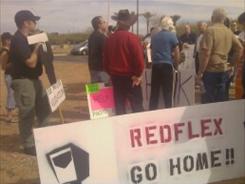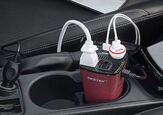Traffic Camera Lobbyists Fight Back In Tenessee And Arizona
Lobbyists for municipalities and photo enforcement companies have succeeded in gutting attempts to place even the most minor of restrictions on the use of red light cameras and speed cameras in Arizona and Tennessee. For more than a year, the Tennessee General Assembly debated the wisdom of restricting the use of automated ticketing machines. A special study committee was established where state House members listened to testimony almost exclusively from representatives of cities and the private, for-profit companies that operate traffic cameras. The committee now has nothing to show for its effort.
On Wednesday, the Senate Transportation Committee voted to scuttle its version of a bill that, although sold as a “restriction” on the use of cameras, reflected a compromise designed to ensure no party with a financial interest in the use of the devices would be offended. As amended in the House, the proposal would have:
- Required warning signs, already in use in most jurisdictions
- Prohibited red light camera tickets on a yellow or green light
- Made the registered owner of a vehicle responsible for crimes committed by anyone else driving the car
- Authorized the state transportation department to use speed cameras on freeways by declaring “work zones”
- Forced a city council vote before installing cameras, which is already done
- Required an engineering study, including setting yellow times at the already lowered ITE standard
- Required a speed camera accuracy check once every six months
- Allowed the state comptroller to audit any photo ticketing contract
- Set the fine at $50, which is what cities already charge
Even though the legislation would have had virtually no effect if enacted, lobbyists feared that a meaningful restriction could have emerged from a conference committee reconciling the difference between the House and Senate-passed measures. For them, it was safer to drop the bill entirely. Earlier this year, the House committee had agreed to some minor protections for motorists, all of which were stripped out by the House amendment (
view HB1341, as amended, 90k PDF).
Despite the dropping of the freeway speed camera program in Arizona yesterday, red light cameras are still active among municipalities statewide. In the name of protecting motorists, lawmakers enacted a signal timing “reform” that makes no difference to either existing practice or existing law. On Monday, Governor Jan Brewer (R) signed House Bill 2338, which adds the following line to the section of state code tasking the Arizona Department of Transportation with designating a manual setting standards for the use of traffic control devices: “The manual shall include the specification that the yellow light duration must be at least three seconds” (
view HB2338, 20k PDF).
The legislation made no other change. Page 28 of Arizona Department of Transportation’s Supplement to the 2003 Manual on Uniform Traffic Control Devices already states: “A yellow change interval should have a duration of approximately three to six seconds.” This line is taken verbatim from the federal manual, which is incorporated by reference as law in all fifty states (
view MUTCD excerpt, 40k PDF).
[Courtesy: Thenewspaper.com]
More by The Newspaper
Latest Car Reviews
Read moreLatest Product Reviews
Read moreRecent Comments
- ToolGuy™ I respect what the seller is doing, but this vehicle is not for me. (Seller doesn't care, has two people lined up already.)
- SCE to AUX How well does the rear camera work in the rain and snow?
- MaintenanceCosts The Truth About Isuzu Troopers!
- Jalop1991 MC's silence in this thread is absolutely deafening.
- MaintenanceCosts Spent some time last summer with a slightly older Expedition Max with about 100k miles on the clock, borrowed from a friend for a Colorado mountain trip.It worked pretty well on the trip we used it for. The EcoBoost in this fairly high state of tune has a freight train feeling and just keeps pulling even way up at 12k ft. There is unending space inside; at one point we had six adults, two children, and several people's worth of luggage inside, with room left over. It was comfortable to ride in and well-equipped.But it is huge. My wife refused to drive it because she couldn't get comfortable with the size. I used to be a professional bus driver and it reminded me quite a bit of driving a bus. It was longer than quite a few parking spots. Fortunately, the trip didn't involve anything more urban than Denver suburbs, so the size didn't cause any real problems, but it reminded me that I don't really want such a behemoth as a daily driver.


































Comments
Join the conversation
Many thanks to TTAC for helping shine the light of scrutiny on these despicable con-men. Once again the mainstream media ignore the truth and the new media steps in.